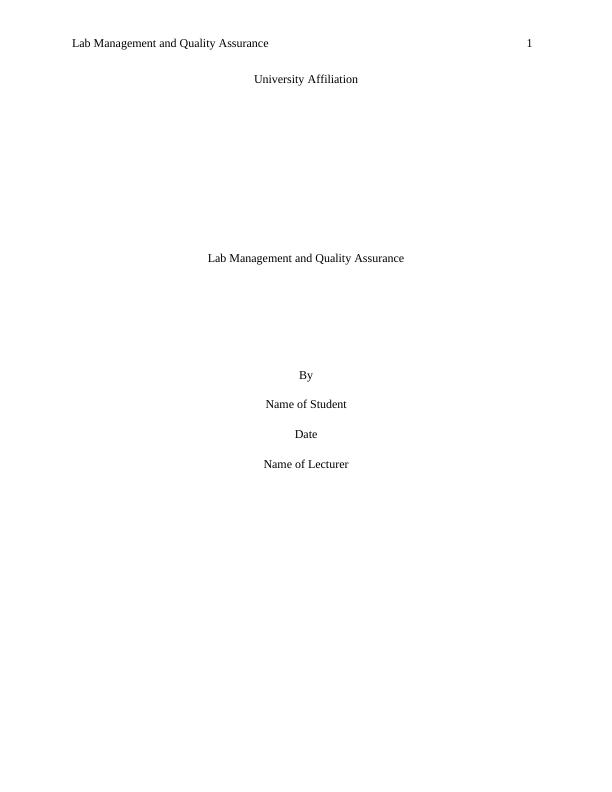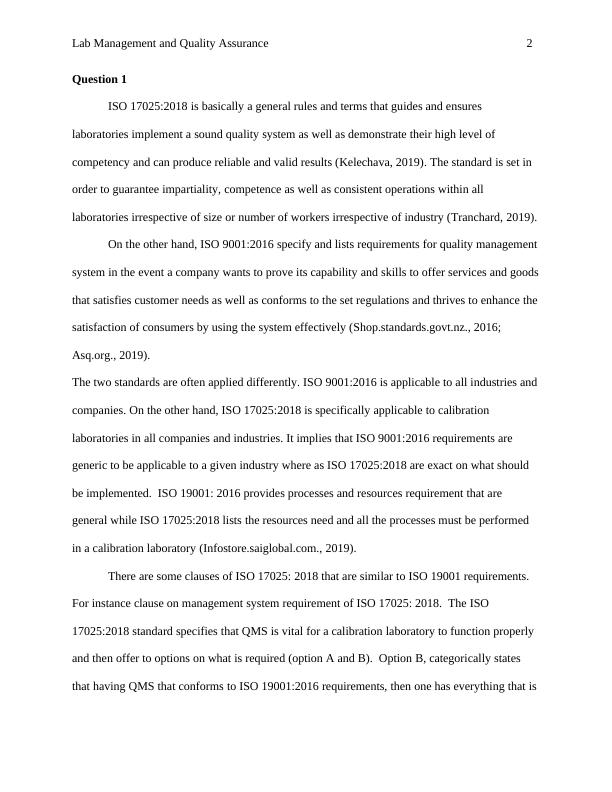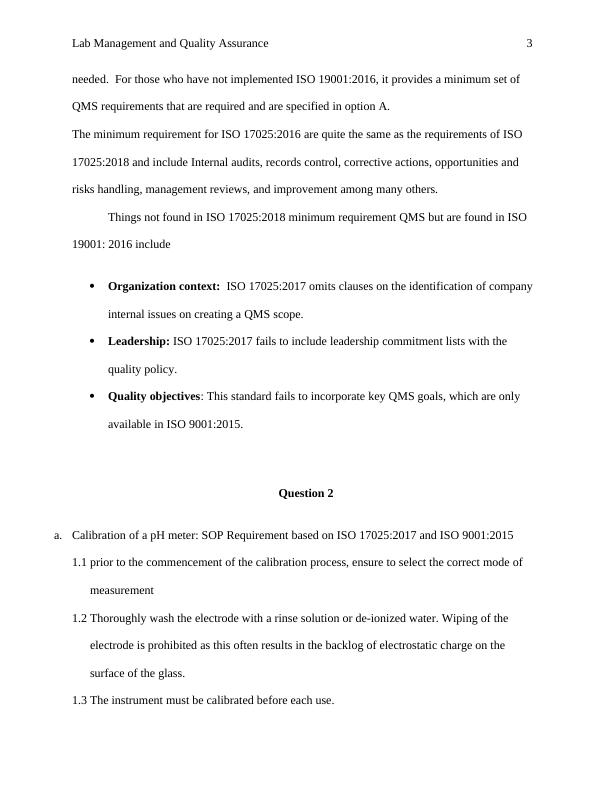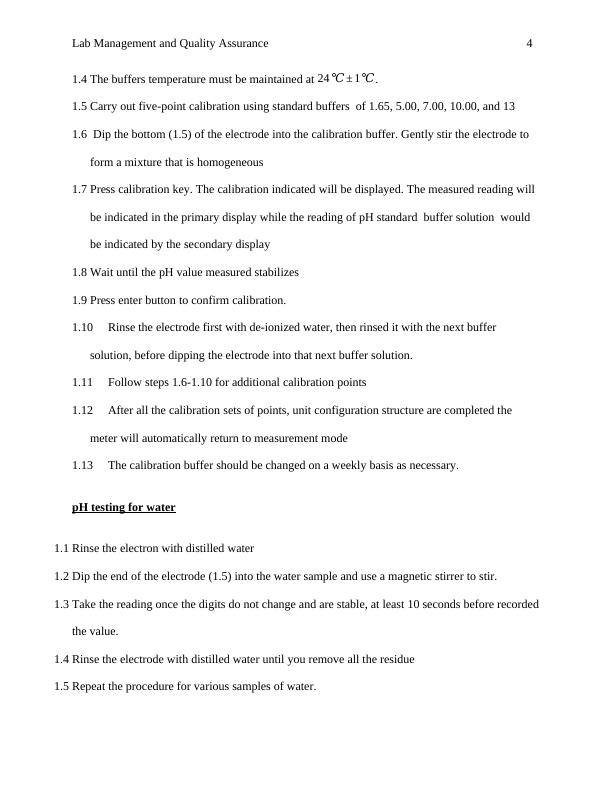Lab Management and Quality Assurance
Added on 2023-03-31
16 Pages2329 Words218 Views
Lab Management and Quality Assurance 1
University Affiliation
Lab Management and Quality Assurance
By
Name of Student
Date
Name of Lecturer
University Affiliation
Lab Management and Quality Assurance
By
Name of Student
Date
Name of Lecturer

Lab Management and Quality Assurance 2
Question 1
ISO 17025:2018 is basically a general rules and terms that guides and ensures
laboratories implement a sound quality system as well as demonstrate their high level of
competency and can produce reliable and valid results (Kelechava, 2019). The standard is set in
order to guarantee impartiality, competence as well as consistent operations within all
laboratories irrespective of size or number of workers irrespective of industry (Tranchard, 2019).
On the other hand, ISO 9001:2016 specify and lists requirements for quality management
system in the event a company wants to prove its capability and skills to offer services and goods
that satisfies customer needs as well as conforms to the set regulations and thrives to enhance the
satisfaction of consumers by using the system effectively (Shop.standards.govt.nz., 2016;
Asq.org., 2019).
The two standards are often applied differently. ISO 9001:2016 is applicable to all industries and
companies. On the other hand, ISO 17025:2018 is specifically applicable to calibration
laboratories in all companies and industries. It implies that ISO 9001:2016 requirements are
generic to be applicable to a given industry where as ISO 17025:2018 are exact on what should
be implemented. ISO 19001: 2016 provides processes and resources requirement that are
general while ISO 17025:2018 lists the resources need and all the processes must be performed
in a calibration laboratory (Infostore.saiglobal.com., 2019).
There are some clauses of ISO 17025: 2018 that are similar to ISO 19001 requirements.
For instance clause on management system requirement of ISO 17025: 2018. The ISO
17025:2018 standard specifies that QMS is vital for a calibration laboratory to function properly
and then offer to options on what is required (option A and B). Option B, categorically states
that having QMS that conforms to ISO 19001:2016 requirements, then one has everything that is
Question 1
ISO 17025:2018 is basically a general rules and terms that guides and ensures
laboratories implement a sound quality system as well as demonstrate their high level of
competency and can produce reliable and valid results (Kelechava, 2019). The standard is set in
order to guarantee impartiality, competence as well as consistent operations within all
laboratories irrespective of size or number of workers irrespective of industry (Tranchard, 2019).
On the other hand, ISO 9001:2016 specify and lists requirements for quality management
system in the event a company wants to prove its capability and skills to offer services and goods
that satisfies customer needs as well as conforms to the set regulations and thrives to enhance the
satisfaction of consumers by using the system effectively (Shop.standards.govt.nz., 2016;
Asq.org., 2019).
The two standards are often applied differently. ISO 9001:2016 is applicable to all industries and
companies. On the other hand, ISO 17025:2018 is specifically applicable to calibration
laboratories in all companies and industries. It implies that ISO 9001:2016 requirements are
generic to be applicable to a given industry where as ISO 17025:2018 are exact on what should
be implemented. ISO 19001: 2016 provides processes and resources requirement that are
general while ISO 17025:2018 lists the resources need and all the processes must be performed
in a calibration laboratory (Infostore.saiglobal.com., 2019).
There are some clauses of ISO 17025: 2018 that are similar to ISO 19001 requirements.
For instance clause on management system requirement of ISO 17025: 2018. The ISO
17025:2018 standard specifies that QMS is vital for a calibration laboratory to function properly
and then offer to options on what is required (option A and B). Option B, categorically states
that having QMS that conforms to ISO 19001:2016 requirements, then one has everything that is

Lab Management and Quality Assurance 3
needed. For those who have not implemented ISO 19001:2016, it provides a minimum set of
QMS requirements that are required and are specified in option A.
The minimum requirement for ISO 17025:2016 are quite the same as the requirements of ISO
17025:2018 and include Internal audits, records control, corrective actions, opportunities and
risks handling, management reviews, and improvement among many others.
Things not found in ISO 17025:2018 minimum requirement QMS but are found in ISO
19001: 2016 include
Organization context: ISO 17025:2017 omits clauses on the identification of company
internal issues on creating a QMS scope.
Leadership: ISO 17025:2017 fails to include leadership commitment lists with the
quality policy.
Quality objectives: This standard fails to incorporate key QMS goals, which are only
available in ISO 9001:2015.
Question 2
a. Calibration of a pH meter: SOP Requirement based on ISO 17025:2017 and ISO 9001:2015
1.1 prior to the commencement of the calibration process, ensure to select the correct mode of
measurement
1.2 Thoroughly wash the electrode with a rinse solution or de-ionized water. Wiping of the
electrode is prohibited as this often results in the backlog of electrostatic charge on the
surface of the glass.
1.3 The instrument must be calibrated before each use.
needed. For those who have not implemented ISO 19001:2016, it provides a minimum set of
QMS requirements that are required and are specified in option A.
The minimum requirement for ISO 17025:2016 are quite the same as the requirements of ISO
17025:2018 and include Internal audits, records control, corrective actions, opportunities and
risks handling, management reviews, and improvement among many others.
Things not found in ISO 17025:2018 minimum requirement QMS but are found in ISO
19001: 2016 include
Organization context: ISO 17025:2017 omits clauses on the identification of company
internal issues on creating a QMS scope.
Leadership: ISO 17025:2017 fails to include leadership commitment lists with the
quality policy.
Quality objectives: This standard fails to incorporate key QMS goals, which are only
available in ISO 9001:2015.
Question 2
a. Calibration of a pH meter: SOP Requirement based on ISO 17025:2017 and ISO 9001:2015
1.1 prior to the commencement of the calibration process, ensure to select the correct mode of
measurement
1.2 Thoroughly wash the electrode with a rinse solution or de-ionized water. Wiping of the
electrode is prohibited as this often results in the backlog of electrostatic charge on the
surface of the glass.
1.3 The instrument must be calibrated before each use.

Lab Management and Quality Assurance 4
1.4 The buffers temperature must be maintained at 24 °C ± 1°C.
1.5 Carry out five-point calibration using standard buffers of 1.65, 5.00, 7.00, 10.00, and 13
1.6 Dip the bottom (1.5) of the electrode into the calibration buffer. Gently stir the electrode to
form a mixture that is homogeneous
1.7 Press calibration key. The calibration indicated will be displayed. The measured reading will
be indicated in the primary display while the reading of pH standard buffer solution would
be indicated by the secondary display
1.8 Wait until the pH value measured stabilizes
1.9 Press enter button to confirm calibration.
1.10 Rinse the electrode first with de-ionized water, then rinsed it with the next buffer
solution, before dipping the electrode into that next buffer solution.
1.11 Follow steps 1.6-1.10 for additional calibration points
1.12 After all the calibration sets of points, unit configuration structure are completed the
meter will automatically return to measurement mode
1.13 The calibration buffer should be changed on a weekly basis as necessary.
pH testing for water
1.1 Rinse the electron with distilled water
1.2 Dip the end of the electrode (1.5) into the water sample and use a magnetic stirrer to stir.
1.3 Take the reading once the digits do not change and are stable, at least 10 seconds before recorded
the value.
1.4 Rinse the electrode with distilled water until you remove all the residue
1.5 Repeat the procedure for various samples of water.
1.4 The buffers temperature must be maintained at 24 °C ± 1°C.
1.5 Carry out five-point calibration using standard buffers of 1.65, 5.00, 7.00, 10.00, and 13
1.6 Dip the bottom (1.5) of the electrode into the calibration buffer. Gently stir the electrode to
form a mixture that is homogeneous
1.7 Press calibration key. The calibration indicated will be displayed. The measured reading will
be indicated in the primary display while the reading of pH standard buffer solution would
be indicated by the secondary display
1.8 Wait until the pH value measured stabilizes
1.9 Press enter button to confirm calibration.
1.10 Rinse the electrode first with de-ionized water, then rinsed it with the next buffer
solution, before dipping the electrode into that next buffer solution.
1.11 Follow steps 1.6-1.10 for additional calibration points
1.12 After all the calibration sets of points, unit configuration structure are completed the
meter will automatically return to measurement mode
1.13 The calibration buffer should be changed on a weekly basis as necessary.
pH testing for water
1.1 Rinse the electron with distilled water
1.2 Dip the end of the electrode (1.5) into the water sample and use a magnetic stirrer to stir.
1.3 Take the reading once the digits do not change and are stable, at least 10 seconds before recorded
the value.
1.4 Rinse the electrode with distilled water until you remove all the residue
1.5 Repeat the procedure for various samples of water.

End of preview
Want to access all the pages? Upload your documents or become a member.
Related Documents
Quality Management in Event Management Industrylg...
|11
|3218
|217
Quality Management - Assignmentlg...
|5
|883
|496
